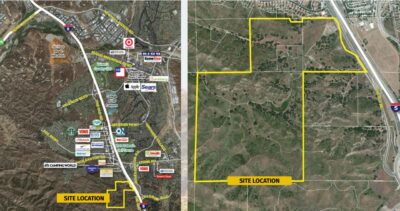The Santa Clarita City Council approved plans Tuesday for 78 condos and 5,200 square feet of retail space on Main Street in Old Town Newhall, a project meant as a bookend to millions of dollars in investment the city has put into Main Street over decades.
Santa Clarita City Councilman Jason Gibbs made a motion that passed 3-0 for what planners called a “full-block development” where Main Street, Market Street and Railroad Avenue meet — a designation that allows a five-story building with underground parking and first-floor retail.
Included in Gibbs’ motion approved by the council was a $450,000 reduction in a $750,000 impact fee the developer had previously agreed to pay to offset the demolition of the old Newhall courthouse building.
Councilwoman Marsha McLean abstained over her concerns about the project.
Jason Tolleson of Serrano Development Group said the project would breathe new life into an area full of businesses that’s struggling without more regular foot traffic a project like The Hartwell could bring. He listed nearly three dozen supporters among the neighboring businesses that make up the Old Town Newhall Association.
“It’s what we need for the growth and vibrancy of Downtown Newhall,” said Dean Cox, a commercial Realtor in Old Town Newhall involved in the project. He helped an Alcoholics Anonymous group that was displaced by the proposed demolition of a historic courthouse, which is in the project’s plans.
“Over the weekends, nighttime, mornings, I’ve never not been able to find a parking space,” Cox said, addressing the parking concerns brought up by some of the project’s opponents. “Do I have to walk a block or two sometimes? Perhaps.”
The project was subject to speculation for months regarding allegations of a backroom deal involving Santa Clarita Mayor Pro Tem Laurene Weste, who acknowledged in a phone interview that she initially negotiated the $750,000 impact fee with Tolleson.
The money was intended as a mitigation measure because the plan calls for the demolition of the SCV’s first courthouse, which was built in the 1930s.
At the start of the council’s discussion on the project Tuesday, Gibbs called for the plan’s approval, but he offered several conditions, mentioning questions about the historical designation of the courthouse as well as the process by which the demolition of the courthouse was initially recommended.
“I am still bewildered as to the timing of the information that has been provided and the process that was instituted for our staff’s recommendation to grant approval for a demolition permit of the building when the project was presented to the planning commission on March 18,” Gibbs said.
Mentioning questions the SCV Historical Society has brought forth about what’s really left of the history in the courthouse, Gibbs’ final motion called for a reduced $300,000 mitigation fee that should be spent on a parking structure instead.
Gibbs also asked for the developer to remove the historic elements of the old courthouse before its demolition.
Santa Clarita Mayor Bill Miranda said that due to technicalities in state law, the city had to approve the project. The city failed to notify Serrano of any potential violations in its objective housing codes within the first 30 days of the project’s submission. This meant the project had to be approved under the state’s Housing Accountability Act, a fact confirmed by City Attorney Joe Montes during the hearing.
While the history of the building has been disputed, a local AA official, David Doyle, who had an office at the courthouse, confirmed Tuesday in a phone interview his office’s window had bars on it from the original jail. The second floor was constructed of wood repurposed from another historic structure, the 1920s Hap-A-Lan Dance Hall
The fee, according to Weste, was for the city, not the SCV Historical Society, which she has been a part of for more than 15 years on its board of directors. She was adamant the situation did not represent a conflict of interest since the money was for the city, and she was negotiating on behalf of Santa Clarita.
However, the City Council request in the agenda called for “a $750,000 monetary contribution from Old Town Main II, LLC to support the mission of the Santa Clarita Historical Society.”
Weste later recused herself at the start of the last hearing for the project.
The SCV Historical Society also figured into the approval of the demolition plans, providing a letter approved by 14 of its 17 board members stating the building was no longer historic due to all of its changes.
Ahead of Tuesday’s discussion, Tolleson also presented a report stating that moving the historic courthouse would cost approximately $2.8 million to $4 million.
The project also called for the demolition of Mac’s Pool Supply (24316 Main St.) and Horseshoe on Main (24300 Main St.).
Tolleson later tried to lower the mitigation fee as part of his reportedly ongoing negotiation with local radio station KHTS. During Tuesday’s hearing, he asked if he could pay $300,000 for historic preservation, with the other $450,000 being made available for potential sound-mitigation measures for the local radio station next door to the project.
Councilwoman Marsha McLean, who felt the project didn’t fit the original vision planners had for Old Town Newhall about a quarter-century ago, said she also objected to the city essentially subsidizing Serrano’s assistance to KHTS by accepting less money for the courthouse mitigation fee.
The city has long envisioned a project like Newhall Crossings, also built by Serrano Development Group, on both ends of Main Street as part of its “park-once” strategy for the area’s development.
The city of Santa Clarita also confirmed its recent plans to add a parking structure near The Hartwell, on two lots the city owns, which are currently being used as parking lots. The city has not yet issued a request for proposals on the project.
The Hartwell calls for 122 parking spaces, according to the proposal, which was a figure established by a city request.
The project’s discussion included the fact that state law could prohibit the city from requiring any parking for the project due to its proximity to the Jan Heidt Metrolink Station, unless the city could prove a negative impact. The city requested a parking study, which is how the number of spaces was determined.








